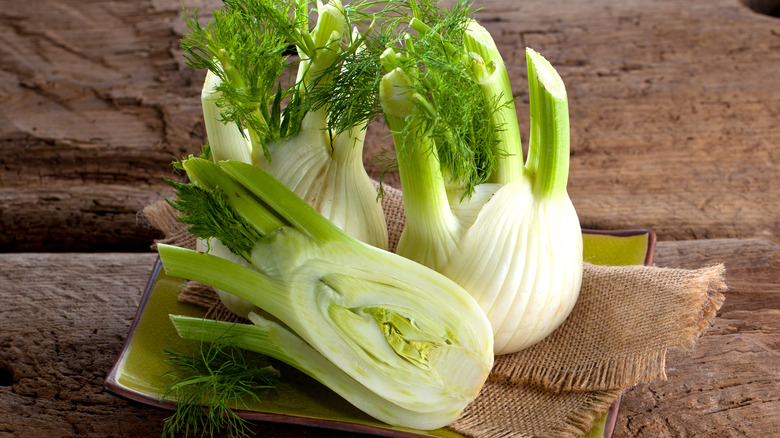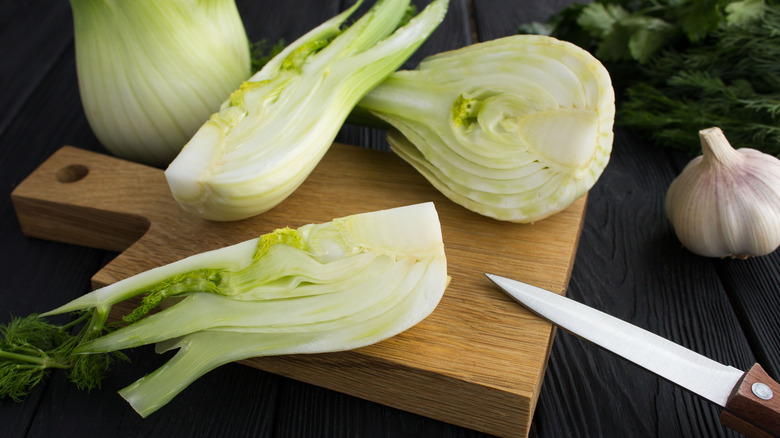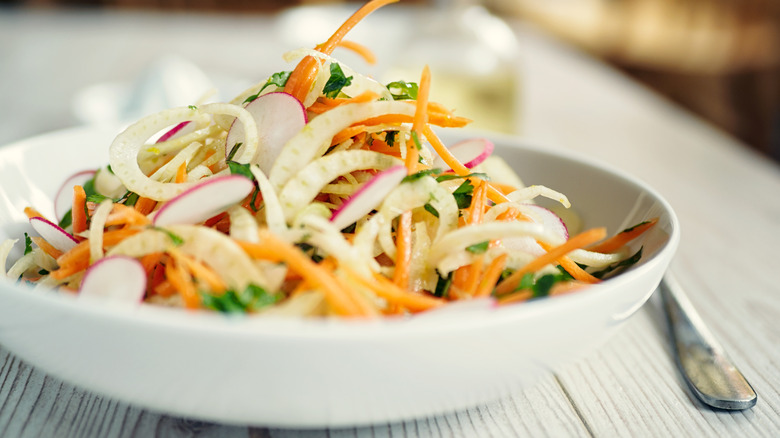The Foolproof Guide To Buying Fennel Like A Veggie Pro
Fennel is a vegetable used commonly in Mediterranean cuisine. It imparts texture and aromatic depth to a variety of dishes, including salads, stews, and meat. Domestically, fennel is seasonally available late fall through early spring. Whether it's bought seasonally at the market or in off-seasons at the grocery store, fennel can introduce a world of culinary opportunity to your kitchen.
However, you might be intimated if it's your first time purchasing this powerhouse veggie. Fennel's appearance has a lot going on, and each part can be used for different applications in the kitchen. Most notably, it has a layered, bulbous base that can be sliced, shaved, or peeled off in leaves. While the bulb looks like an onion, the vegetable is more closely related to carrots, and the flavor is milder and less pungent, with notes of anise and licorice. Its thick, layered leafs shoot off into fibrous stalks, which have feathery green leaves called fronds that look like dill. When fennel matures, it flowers and can produce the seeds you've likely seen dried.
If you're buying fennel for the first time, don't let the complex appearance deter you from this flavorful produce. To get the most out of the versatile veggie, look for a firm, bright white bulb, along with stalks and fronds that are vibrant in color, firm, and intact.
To get the most out of your fennel, choose one with stalks
Fennel is sometimes sold with the stalks and fronds removed from the heavy, bulbous base. However, if you have the opportunity to buy one with the leafy stalks attached, go for it. The stalks keep the bulbs from drying out and can be used in an array of cooking opportunities, allowing for a no-waste kitchen experience.
When buying fennel at the farmers market or grocery store, you'll want to select one that has a firm bulb, free of bruises or blemishes, with stalks that are at least three inches tall. Avoid ones where the bulbs or stalks are starting to become or have gone pale in color or rubbery and limp to the touch. Many recipes call for peeling the outer layers off of the bulb. But if you select one that's firm, you won't have to waste those outer layers, which make up a large portion of the vegetable and taste great when fresh.
Upon bringing your fennel home, remove the stalks and fronds from the bulb with a knife and store them in airtight containers or bags in the fridge for up to a week. For the freshest, firm fennel, use the veggie promptly.
How to prepare fennel
If you buy firm, fresh fennel, every part of the vegetable can be used. To prepare fennel, remove the stalks from the bulbous base of the vegetable, then slice off the root to provide a stable base to sit on your cutting board. Cut the bulb down the center lengthwise, then once more into quarters, which can be sliced for cooking and grilling, or shaved with a mandoline and eaten raw.
When prepared raw, shaved fennel will seriously elevate a salad or slaw, in recipes such as fennel salad with red onion, parsley, and lemon, especially when paired with brightly acidic vinagrettes. Shaved fennel adds a delightful crunch and enhances fruity or sweet flavor notes in dishes such as homemade truffled apple fennel slaw. When cooked on the grill or sautéed with onions as a base to a stew, the texture becomes tender and soft, and the flavor is enhanced, adding an earthy sweetness and warm spice undertones to your dish.
Cut and dice the roots and use them as you would carrots in a stew, and save the fibrous stalks to impart flavor in stocks and soups. Add the delicate, feathery fronds into sauces and pastas as an herbaceous accent or garnish, as you would with dill. To save sliced or shaved fennel for later, store it submerged in water in an airtight container in the fridge, or lay the slices out on a prepared baking sheet and transfer to the freezer.


